Euro 2020 is well and truly underway, with all 24 teams having played their first match of the tournament. Monday’s clash between Poland and Slovakia gave us arguably the first shock result, with Poland losing 2-1 after struggling to find a way through Slovakia’s organised defensive setup. In this tactical analysis, we will look in closer detail at the tactics that helped Slovakia win what was a very interesting game. The analysis will look at their changing shape, pressing, counter-attacking, and the way that Poland created more space in Slovakia’s half in the second 45 minutes, but still found the door shut by their opponents.
Defensive shape
The first thing to look at in this scout report is Slovakia’s defensive shape. Their back line was marshalled superbly throughout the game by Inter Milan defender Milan Skriniar, who was a key factor in his side’s Serie A title win this season, and he has brought that confidence to the international stage this summer too.

Here, Slovakia have set up with two lines of four, using this low block to stop Poland playing the ball forwards. There is a small amount of open space between the two lines, and three Polish players are positioned in there. However, this doesn’t pose a problem for Slovakia, as the forwardmost line of four have positioned themselves next to the wing, preventing a forward pass from being made; Poland have to play backwards as a result, with the three attackers in the space cut off from the rest of the team.
The most noticeable thing about Slovakia’s defence was that it was not fixed, with the number of players back there changing regularly. This meant that Poland could never find a way through them, as they were never sure of where the space would be available and when, so Slovakia’s flexibility in defence was a key factor in their eventual win.
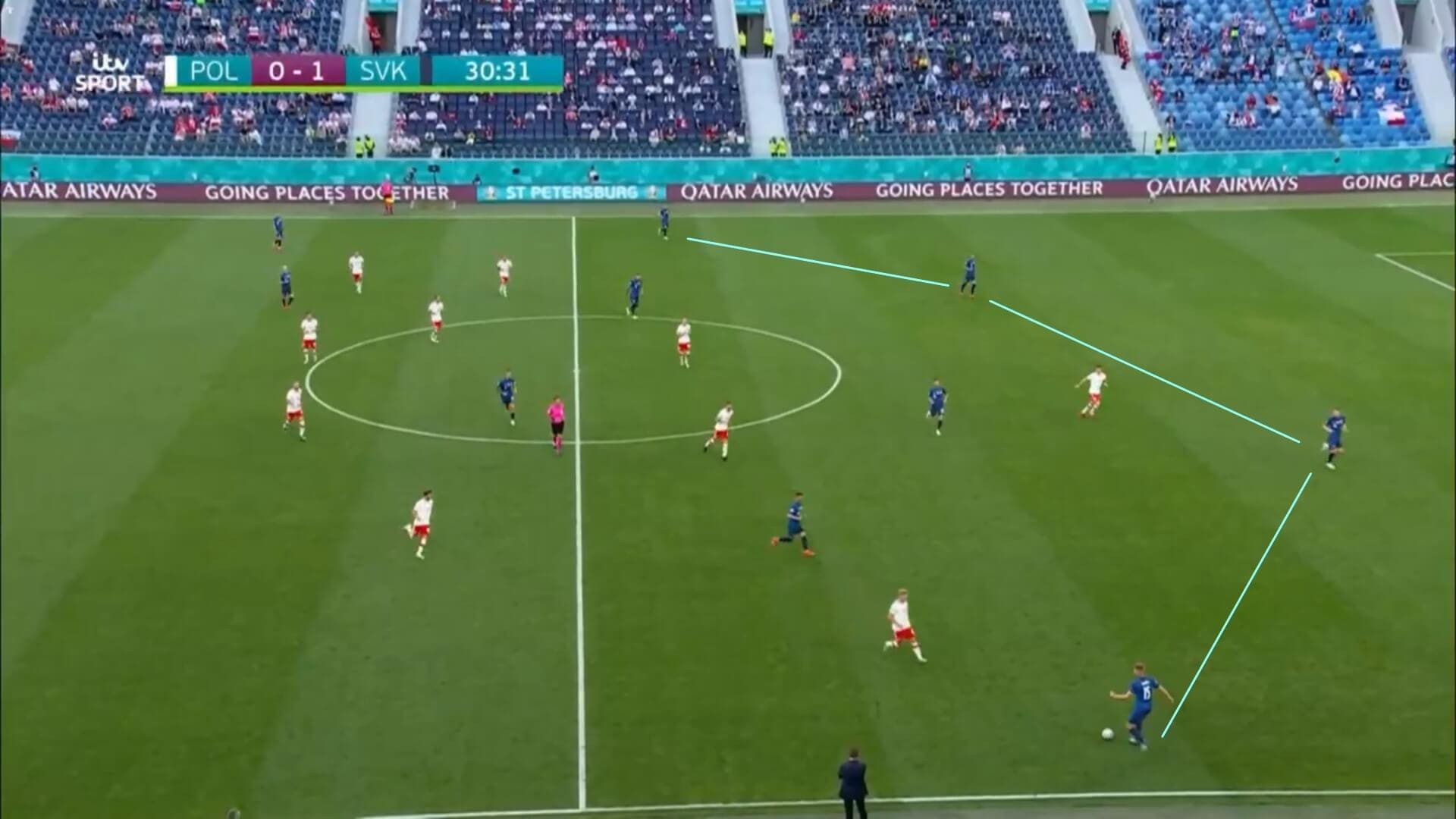
In possession, Slovakia made the pitch as big as possible, as this image shows. The two centre-backs have stretched out, which in turn allows the full-backs to play further up the pitch, leading to the shape that we see in this image. Now, Slovakia can create passing options around the pitch, but don’t need to rush a forward pass. Instead, their wide defensive line means they can make sideways passes and keep the ball until a way ahead opens up, so this again shows their strength and composure at the back.
From Poland’s point of view, their players are positioned narrowly in this image, with Slovakia’s full-backs having plenty of time and space to advance up the pitch in the wide channels, and this was a constant throughout the game. If we contrast this with the previous image, we can see the difference between Slovakia in and out of possession, again demonstrating how well-drilled they were. This was another reason why Poland found it difficult to break them down.
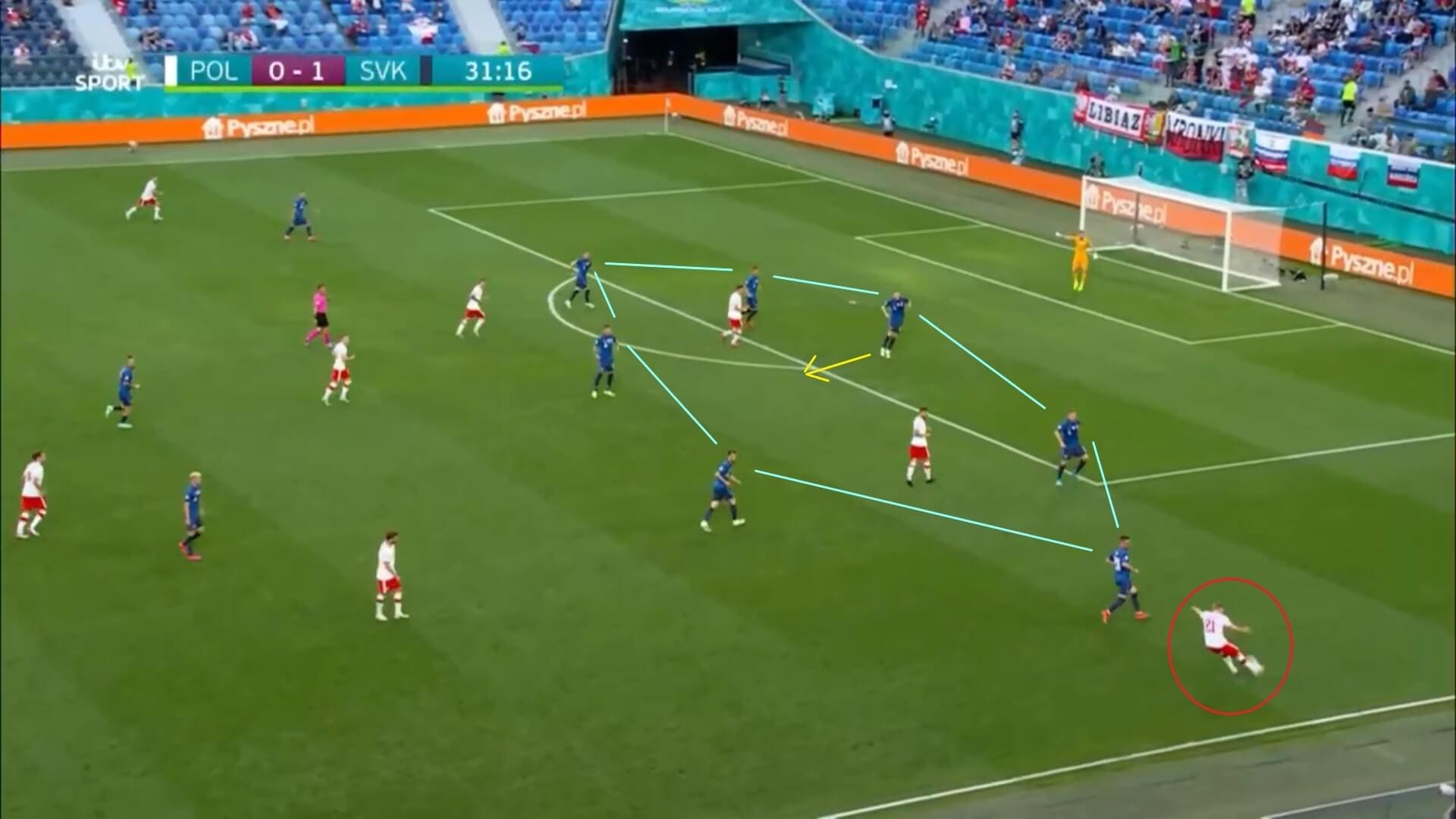
When Poland did have opportunities to move the ball into the box, Slovakia limited the space available to them, working together to surround the central Polish options. Here, they have formed a circular shape on the edge of the box, forcing Derby County winger Kamil Jozwiak, in the red circle, to pass into that area. This is because there are no other options available outside the circle, because Slovakia’s defensive shape has again caused them problems.
Slovakia know where the ball is going, and can ensure they clear it before it reaches Robert Lewandowski. The Bayern Munich striker is positioned inside the D in this image, meaning the ball has a long way to travel before it reaches him, but Skriniar makes the interception when it does come in, as the yellow arrow shows, ending the danger. Slovakia never panicked when Poland got into these areas of the pitch, and simply worked together to keep control of the situation.
This section has shown us three ways that Slovakia’s defensive shape helped them to beat Poland, and we can expect to see more of these structures in their last two group games. Spain and Sweden played out a goalless draw in their first game on Monday, with both lacking an end-product, so Slovakia will be confident of keeping both at bay with the level of defensive organisation they displayed here.
Pressing
Whilst their ever-changing defensive shape was crucial, it was Slovakia’s pressing that caused Poland more problems, as they were forced to play the ball quicker than they would have preferred and couldn’t create chances with enough accuracy.
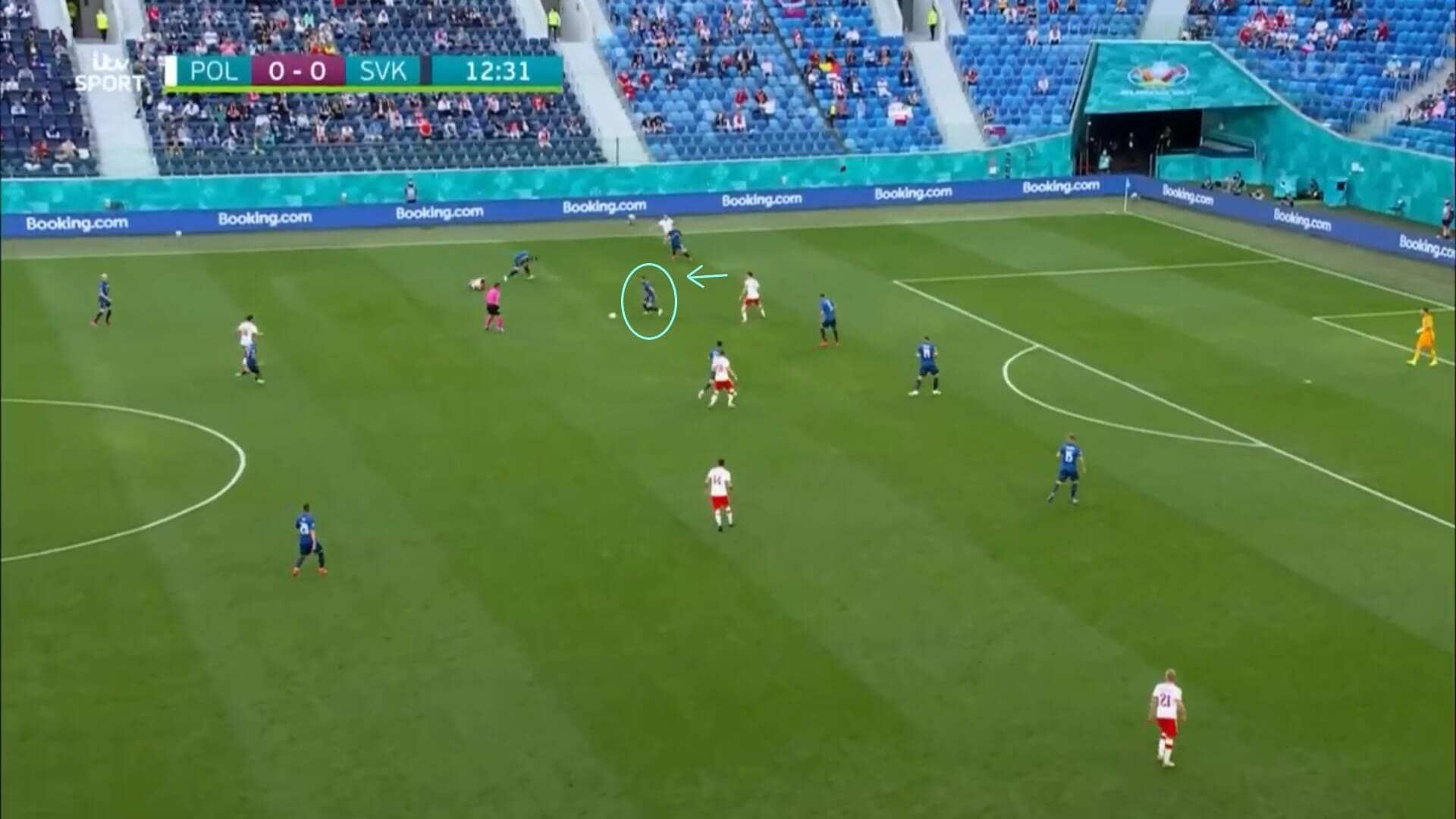
It may have looked like Slovakia were always on the back foot, but this was not the case. Instead, they came out at every opportunity to win the ball early, ensuring that Poland never had time or space in which to make decisions.
This came from Slovakia’s aforementioned defensive setup, and there are five players in their defensive line here. The increase in numbers allows one player to move out and close the ball down, as the blue arrow shows. Normally, this would leave the space open for Poland to exploit, but the extra player allows Slovakia to adequately cover the gap. Therefore, we can see again how Slovakia’s defensive shape and teamwork was essential, but also how the ability of individual players to be flexible and slot in where needed allowed those nearer the ball to close it down.
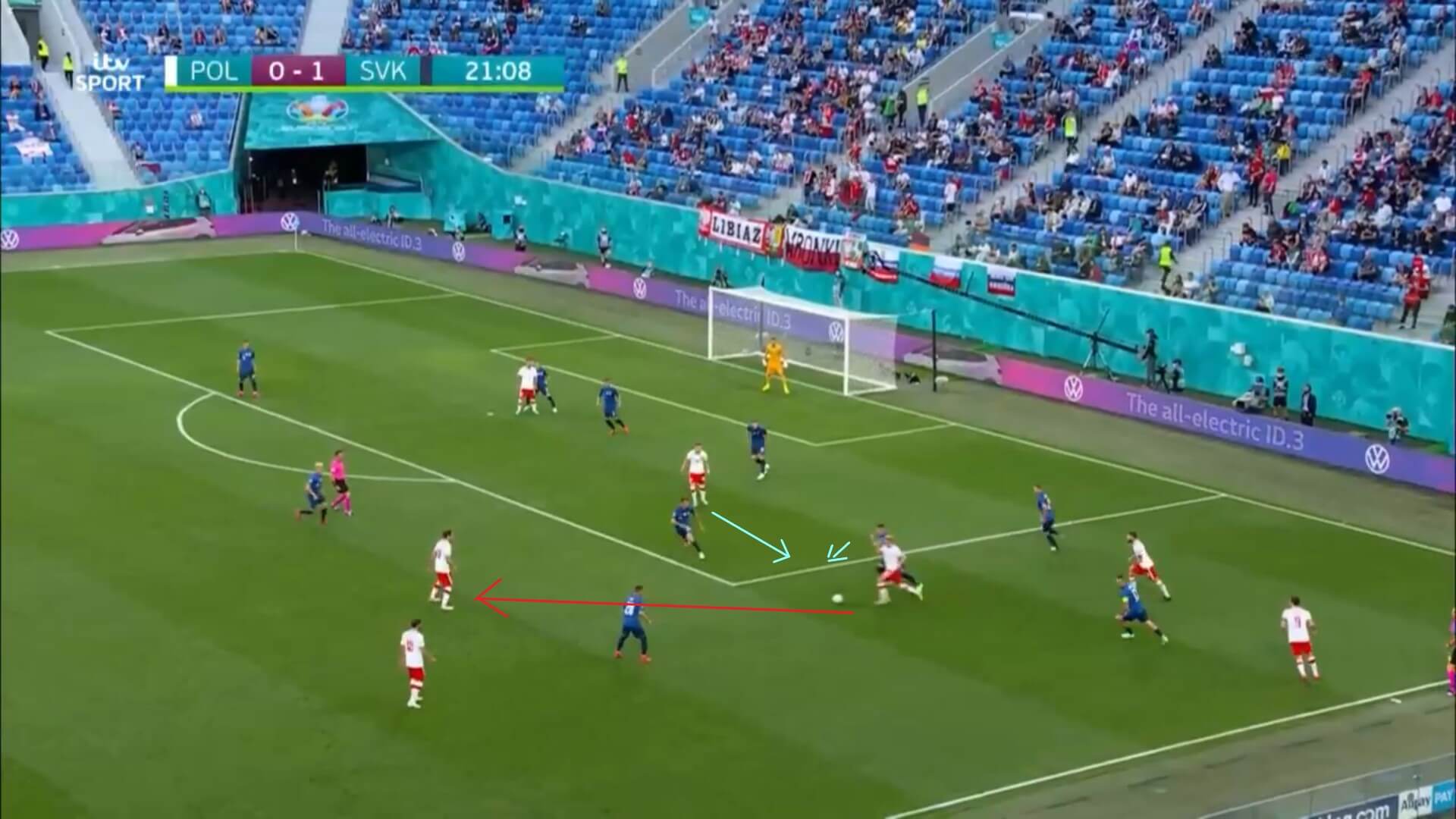
Pressing in two’s and three’s was also a major part of Slovakia’s play when Poland were in their third. Here, Jozwiak is looking for a teammate in the goal area, but there is no-one available to receive the ball. This means he is now caught in possession, and two Slovakian defenders have moved to close him down, as the blue arrows show, forcing him to pass backwards. With this being a rushed pass, he hits it too hard, and Poland lose possession as a result. This is therefore another example of Slovakia ensuring Poland had a torrid time in attack.
It is always easier to block opponents when they are on the wings, but defenders still need to communicate well and know when to press and when to stay back and offer more protection, and this was something Slovakia had in abundance. Therefore, this was another essential ingredient in their win.
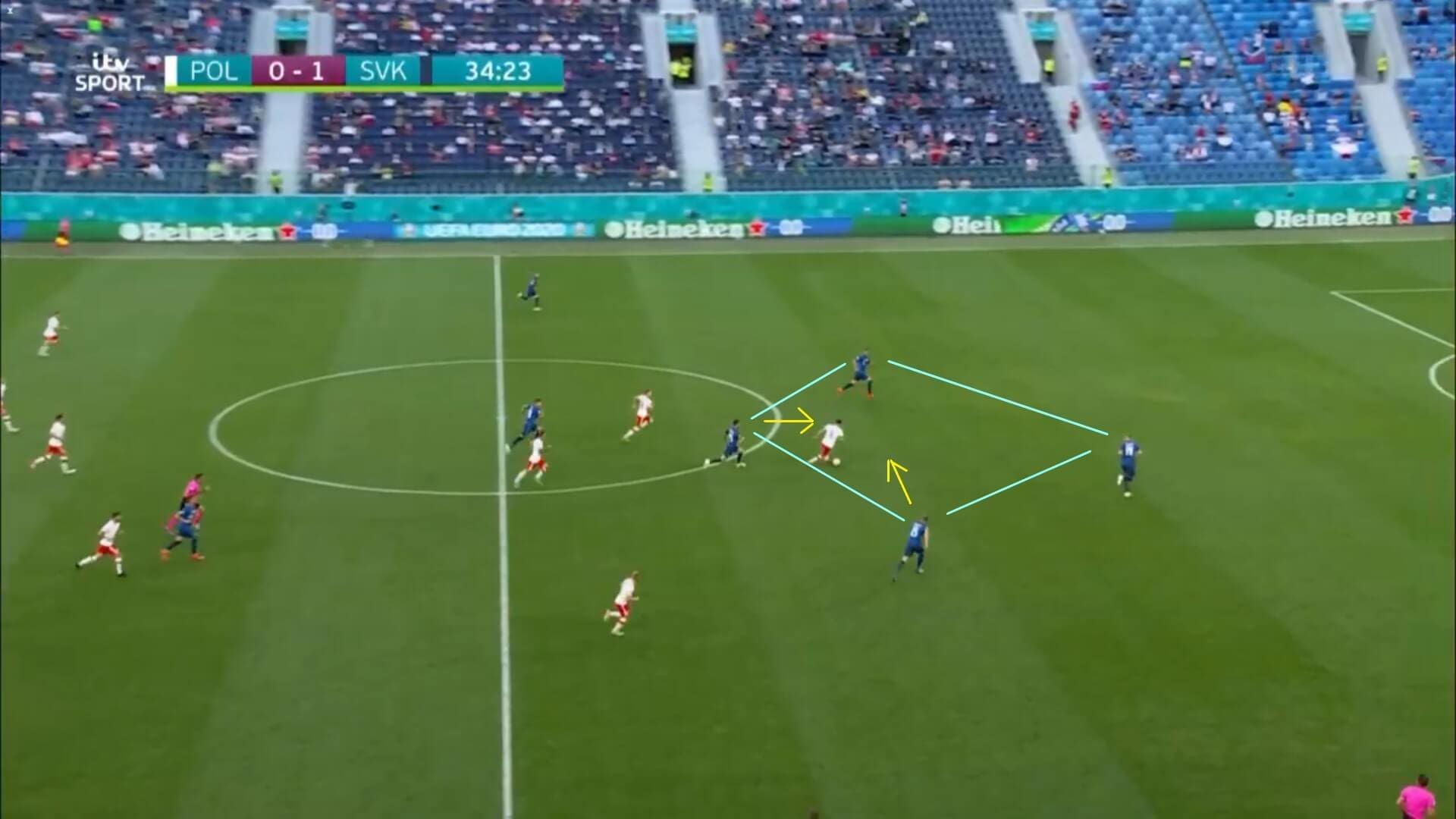
Lewandowski had a quiet game by his standards, with Slovakia stopping Poland’s service into him during the majority of the game. However, when last season’s top scorer in the Bundesliga did get the ball, Slovakia were ready. Here, there are four players around the Poland captain, with two watching his movement, whilst the others run inwards to close him down. As a result, Lewandowski was forced to pass the ball earlier than he would have preferred, and Poland’s attack fizzles out. This all came simply because of the way Slovakia got around the ball quickly, therefore demonstrating why this was a key factor in their win.
Counter-attacking
From what we have looked at so far in this scout report, you would be forgiven for thinking that Slovakia defended for the whole game. However, they were actually playing a counter-attacking style of football, helped by their forward line not containing a recognised striker, as this meant that those players were free to drift around the pitch and make it harder for Poland to mark them.

However, as the forwards were all wingers or midfielders, they also came back to help the defensive effort when Poland had the ball, before then getting forwards as soon as Slovakia reclaimed possession. This is what we can see in this image.
What is particularly noticeable here is how the three attackers run forwards at different angles. This makes the pitch bigger and gives Slovakia passing options in different areas around the pitch. This again shows the organisation that Slovakia had, with the attackers coming together when out of possession, before making the pitch as big as possible when they had a chance to attack. Small details like this were what helped them to win this game.
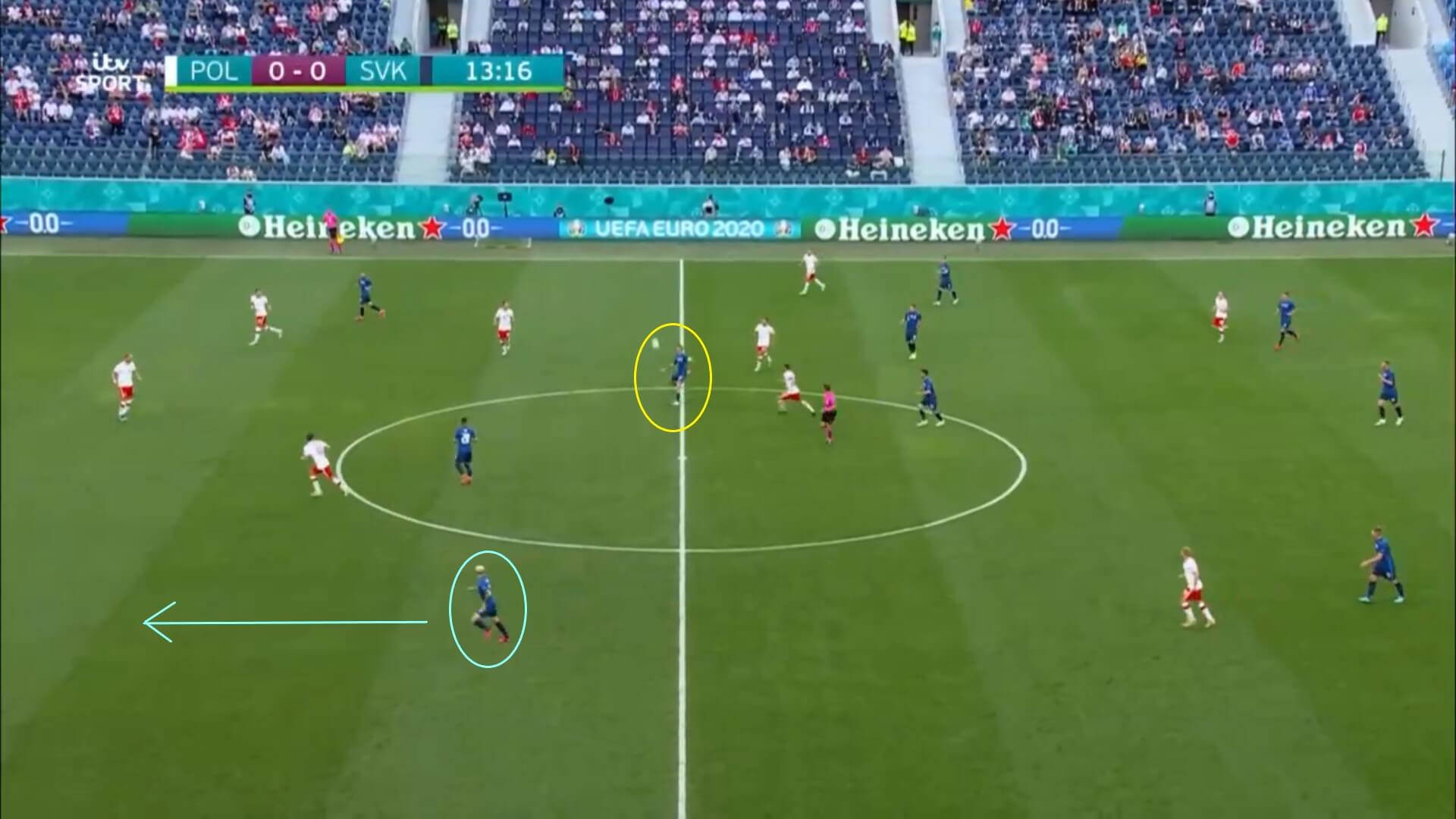
When they did play the ball out from the back, Slovakia were decisive with their passing, never hesitating and giving Poland time to close them down. They tend to play through the thirds when they can, decreasing the chance of the ball being lost aerially during defence-to-attack transitions. This image shows how captain Marek Hamsik, in the yellow circle, is playing a volleyed pass towards the nearside wing, where Duda has made a run into the space.
Therefore, with just two passes, Slovakia have transferred the ball into a dangerous area, and can get a shot away at goal. Poland weren’t alive to these tactics, as shown by the amount of space Hamsik has to play in, but we should take nothing away from Slovakia here, as their accurate passing and ball control in these situations was the reason for their counter-attacking success.
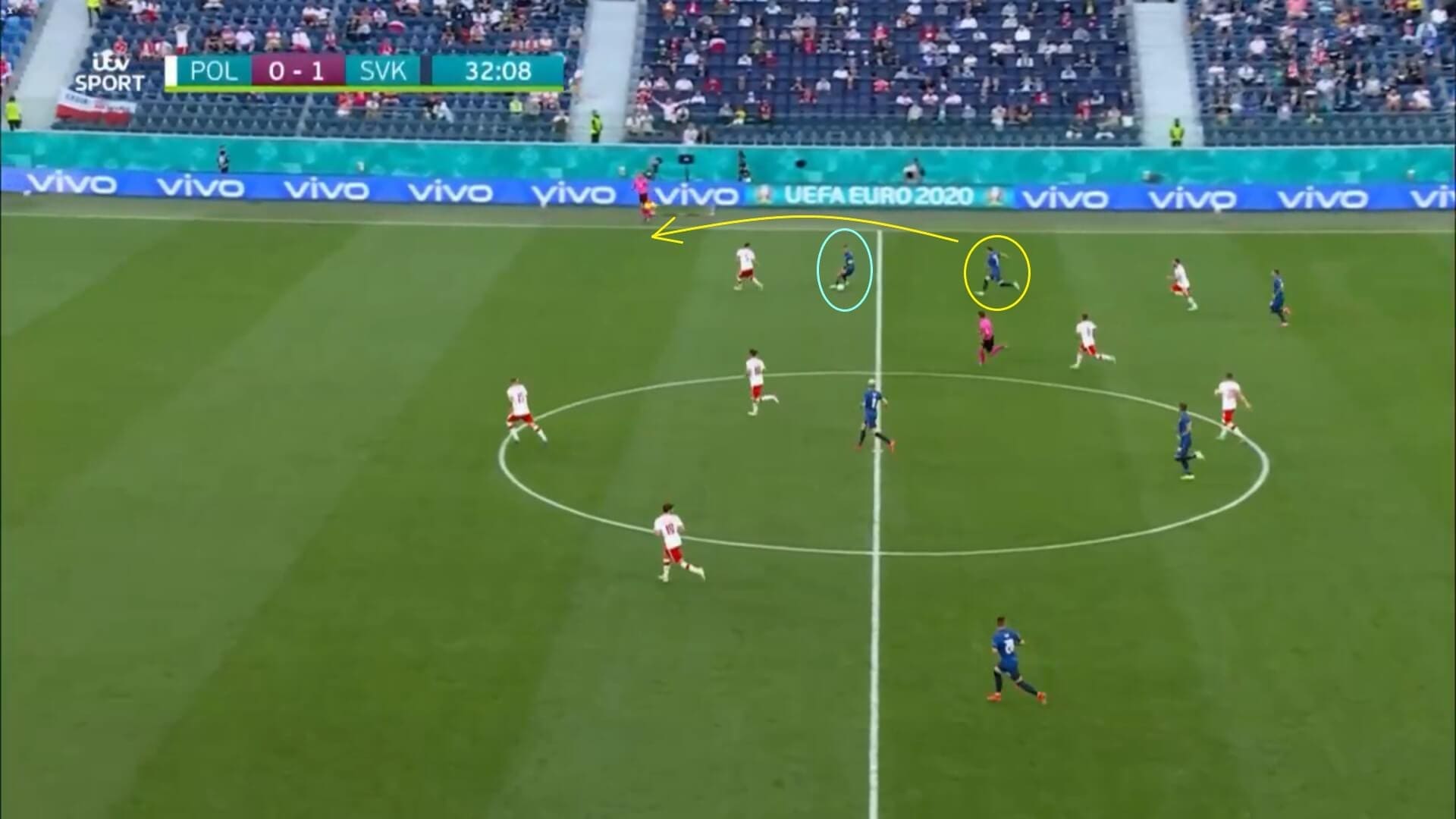
Much like their defence, the number of players in Slovakia’s forward line, and which players were there, constantly altered throughout the game, again making it hard for Poland to defend against them. Even when it looked like Poland had halted their run, others got forward to help Slovakia continue their attack, as right-back Peter Pekarik is doing here. His run around the outside of the Polish defence on the far side wing gives his team a passing option in the space behind, and one which would then allow Slovakia to transfer the ball into the box.
Therefore, what we can take from this is that every Slovakian player knew where to be both defensively and when going forwards, and this, coupled with their passing speed and ability to occupy different areas of the pitch, was another big reason for their win.
Dealing with Poland’s second half changes
In the second half, Poland changed their tactics, and Slovakia found it harder to keep control of the game in the same way.
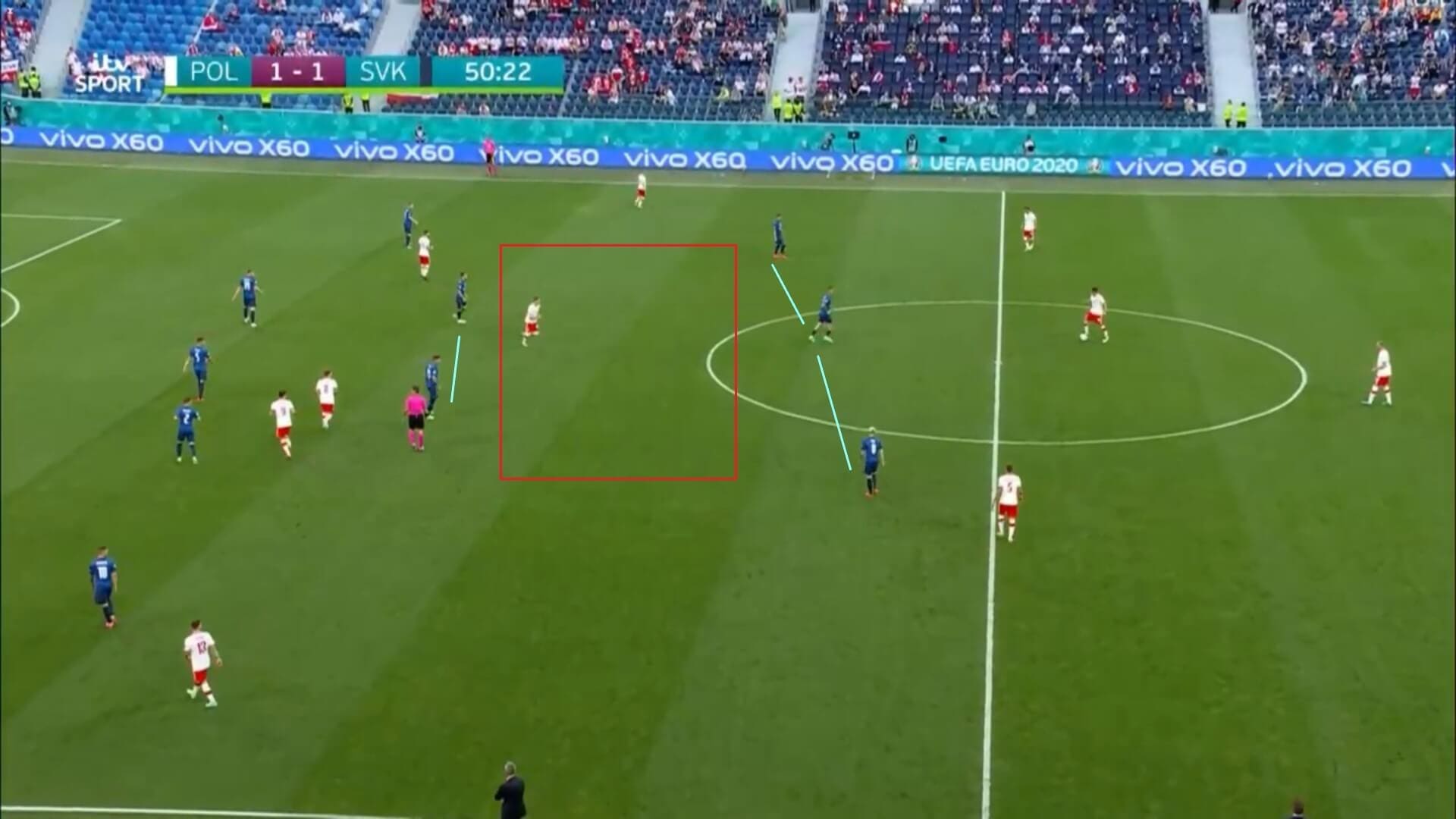
One of the main problems in the first half for Poland first was that Slovakia didn’t allow them to access the space behind their defence. However, in the second half, Lewandowski took up a position between the Slovakian defenders, which forced Slovakia to close off the gap between their defence and midfield lines, trying to stop Poland from using that space to find the striker. However, because the forward line remained higher up the field, a gap was created between them and the midfield line, shown here by the red square. This enabled Poland to link up their attacking play more, with their midfielders operating in that space and playing the ball forwards more.
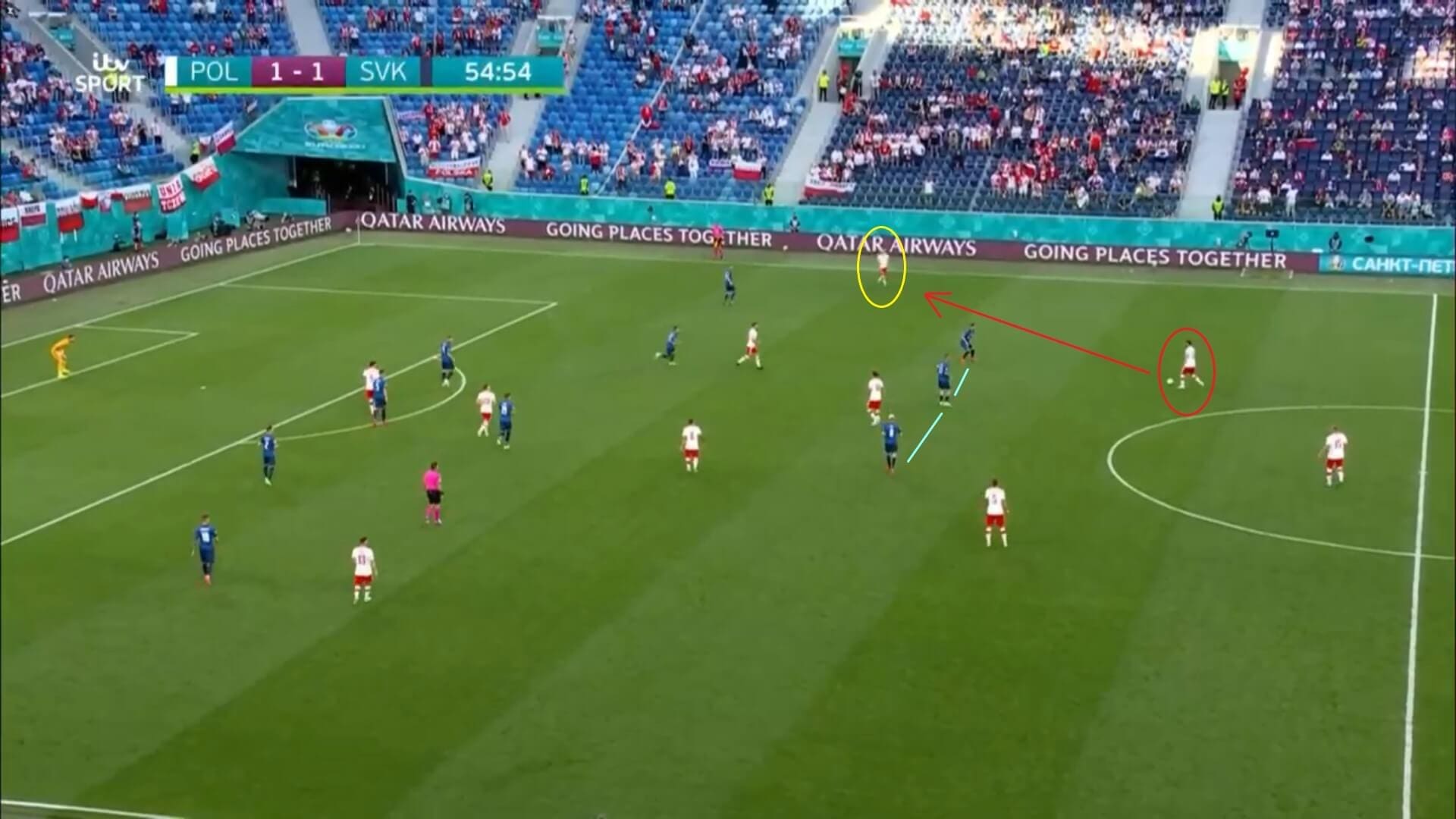
The forward line became increasingly isolated in the second half, and looked unsure of whether to press the Polish players or get back and help at the back. In the end, they did neither, which allowed Poland to get players into the wide channels and then to play the ball into those spaces, demonstrated here by the red arrow. The theory behind this was that, by controlling those areas of the pitch, Poland could then transfer the ball into the middle with more ease, creating more opportunities. However, Slovakia’s defence maintained its organisation, clearing balls whenever they came into the box.
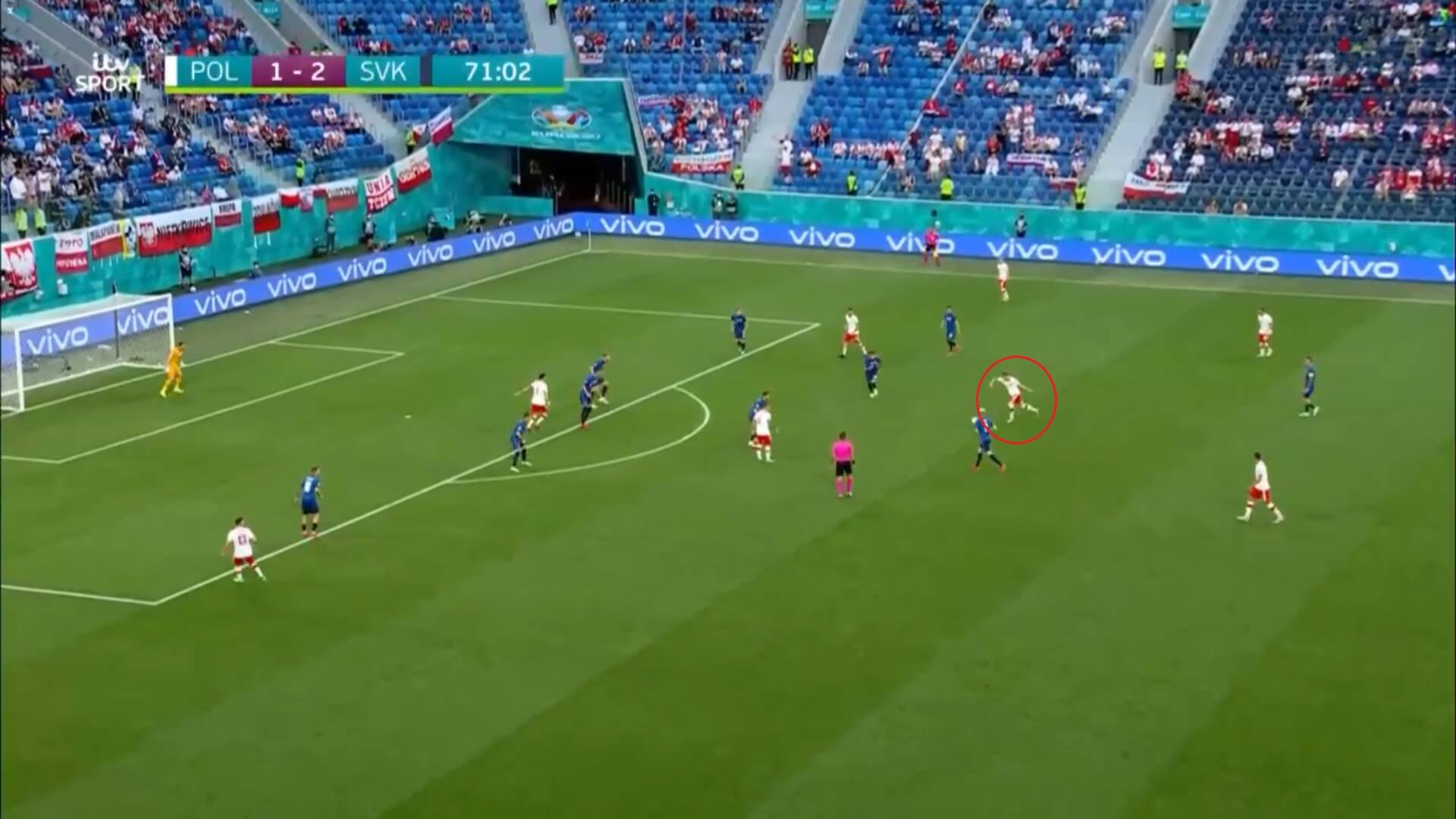
Therefore, whilst Poland were stronger in the second half, Slovakia’s organised approach at the back remained too strong for them to break down, and the Polish players were instead forced to shoot from distance rather than from inside the box. Here, the shot from Napoli midfielder Piotr Zielinski, in the red circle, goes a long way over the bar, which summed up Poland’s game; they increasingly found pockets of space, but were never able to convert their opportunities into anything, with Slovakia keeping their discipline throughout.
Conclusion
In conclusion, there were a number of reasons for Poland’s inability to break Slovakia down. We have looked in this analysis at Slovakia’s defensive setup, and how they constantly changed the number of players at the back to keep their opponents guessing, as well as their pressing when out of possession and their counter-attacking play. Poland played better in the second half, manipulating Slovakia’s defence more, but, aside from Karol Linetty’s goal a minute into the second half, they never looked able to turn their attacking threat into anything substantial, with Slovakia remaining steadfast and forcing them to shoot from distances. With performances like this, there is no doubt that Slovakia will be a handful for any team they face during the remainder of the tournament.





Comments